This package contains connectors and partial models for 1-dim. translational mechanical components. The components of this package can only be used as basic building elements for models.
Extends from Modelica.Icons.InterfacesPackage (Icon for packages containing interfaces).
| Name | Description |
|---|---|
| (left) 1D translational flange (flange axis directed INTO cut plane, e. g. from left to right) | |
| (right) 1D translational flange (flange axis directed OUT OF cut plane) | |
| Support/housing 1D translational flange | |
| Adapter model to utilize conditional support connector | |
| Component with two translational 1D flanges | |
| Partial model for a component with one translational 1-dim. shaft flange and a support used for graphical modeling, i.e., the model is build up by drag-and-drop from elementary components | |
| Partial model for a component with two translational 1-dim. shaft flanges and a support used for graphical modeling, i.e., the model is build up by drag-and-drop from elementary components | |
| Rigid connection of two translational 1D flanges | |
| Compliant connection of two translational 1D flanges | |
| Base model for the compliant connection of two translational 1-dim. shaft flanges where the relative position and relative velocities are used as states | |
| Obsolete partial model. Use PartialElementaryOneFlangeAndSupport2. | |
| Partial model for a component with one translational 1-dim. shaft flange and a support used for textual modeling, i.e., for elementary models | |
| Obsolete partial model. Use PartialElementaryTwoFlangesAndSupport2. | |
| Partial model for a component with one translational 1-dim. shaft flange and a support used for textual modeling, i.e., for elementary models | |
| Partial model to transform rotational into translational motion | |
| Partial model of a force acting at the flange (accelerates the flange) | |
| Device to measure a single absolute flange variable | |
| Device to measure a single relative variable between two flanges | |
| PartialFriction | Base model of Coulomb friction elements |
 Modelica.Mechanics.Translational.Interfaces.Flange_a
Modelica.Mechanics.Translational.Interfaces.Flange_a

The following variables are transported through this connector:
s: Absolute position of the flange in [m]. A positive translation
means that the flange is translated along the flange axis.
f: Cut-force in direction of the flange axis in [N].
| Type | Name | Description |
|---|---|---|
| Position | s | Absolute position of flange [m] |
| flow Force | f | Cut force directed into flange [N] |
connector Flange_a "(left) 1D translational flange (flange axis directed INTO cut plane, e. g. from left to right)" SI.Position s "Absolute position of flange"; flow SI.Force f "Cut force directed into flange";end Flange_a;
 Modelica.Mechanics.Translational.Interfaces.Flange_b
Modelica.Mechanics.Translational.Interfaces.Flange_b

The following variables are transported through this connector:
s: Absolute position of the flange in [m]. A positive translation
means that the flange is translated along the flange axis.
f: Cut-force in direction of the flange axis in [N].
| Type | Name | Description |
|---|---|---|
| Position | s | Absolute position of flange [m] |
| flow Force | f | Cut force directed into flange [N] |
connector Flange_b "(right) 1D translational flange (flange axis directed OUT OF cut plane)" SI.Position s "Absolute position of flange"; flow SI.Force f "Cut force directed into flange";end Flange_b;
 Modelica.Mechanics.Translational.Interfaces.Support
Modelica.Mechanics.Translational.Interfaces.Support

This is a connector for 1-dim. rotational mechanical systems and models the support or housing of a shaft. The following variables are defined in this connector:
s |
Absolute psotion of the support/housing in [m] |
f |
Reaction force in the support/housing in [N] |
The support connector is usually defined as conditional connector. It is most convenient to utilize it
| Type | Name | Description |
|---|---|---|
| Position | s | Absolute position of flange [m] |
| flow Force | f | Cut force directed into flange [N] |
connector Support "Support/housing 1D translational flange" SI.Position s "Absolute position of flange"; flow SI.Force f "Cut force directed into flange";end Support;
 Modelica.Mechanics.Translational.Interfaces.InternalSupport
Modelica.Mechanics.Translational.Interfaces.InternalSupport

This is an adapter model to utilize a conditional support connector in an elementary component, i.e., where the component equations are defined textually:
Variable f is defined as input and must be provided when using this component as a modifier (computed via a force balance in the model where InternalSupport is used). Usually, model InternalSupport is utilized via the partial models:
PartialElementaryOneFlangeAndSupport,
PartialElementaryTwoFlangesAndSupport,
PartialElementaryRotationalToTranslational.
Note, the support position can always be accessed as internalSupport.s, and the support force can always be accessed as internalSupport.f.
| Type | Name | Description |
|---|---|---|
| Flange_a | flange | Internal support flange (must be connected to the conditional support connector for useSupport=true and to conditional fixed model for useSupport=false) |
model InternalSupport
"Adapter model to utilize conditional support connector"
input SI.Force f
"External support force (must be computed via force balance in model where InternalSupport is used; = flange.f)";
SI.Position s "External support position (= flange.s)";
Flange_a flange
"Internal support flange (must be connected to the conditional support connector for useSupport=true and to conditional fixed model for useSupport=false)";
equation
flange.f = f;
flange.s = s;
end InternalSupport;
 Modelica.Mechanics.Translational.Interfaces.PartialTwoFlanges
Modelica.Mechanics.Translational.Interfaces.PartialTwoFlanges

This is a 1D translational component with two flanges. It is used e.g., to built up parts of a drive train consisting of several base components.
| Type | Name | Description |
|---|---|---|
| Flange_a | flange_a | (left) driving flange (flange axis directed in to cut plane, e. g. from left to right) |
| Flange_b | flange_b | (right) driven flange (flange axis directed out of cut plane) |
partial model PartialTwoFlanges "Component with two translational 1D flanges "Flange_a flange_a "(left) driving flange (flange axis directed in to cut plane, e. g. from left to right)"; Flange_b flange_b "(right) driven flange (flange axis directed out of cut plane)"; end PartialTwoFlanges;
 Modelica.Mechanics.Translational.Interfaces.PartialOneFlangeAndSupport
Modelica.Mechanics.Translational.Interfaces.PartialOneFlangeAndSupport
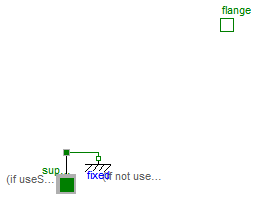
This is a 1-dim. translational component with one flange and a support/housing. It is used e.g., to build up parts of a drive train graphically consisting of several components.
If useSupport=true, the support connector is conditionally enabled
and needs to be connected.
If useSupport=false, the support connector is conditionally disabled
and instead the component is internally fixed to ground.
| Type | Name | Default | Description |
|---|---|---|---|
| Boolean | useSupport | false | = true, if support flange enabled, otherwise implicitly grounded |
| Type | Name | Description |
|---|---|---|
| Flange_b | flange | Flange of component |
| Support | support | Support/housing of component |
partial model PartialOneFlangeAndSupport
"Partial model for a component with one translational 1-dim. shaft flange and a support used for graphical modeling, i.e., the model is build up by drag-and-drop from elementary components"
parameter Boolean useSupport=false
"= true, if support flange enabled, otherwise implicitly grounded";
Flange_b flange "Flange of component";
Support support if useSupport "Support/housing of component";
protected
Support internalSupport
"Internal support/housing of component (either connected to support, if useSupport=true, or connected to fixed, if useSupport=false)";
Components.Fixed fixed if not useSupport
"Fixed support/housing, if not useSupport";
equation
connect(fixed.flange, internalSupport);
connect(internalSupport, support);
end PartialOneFlangeAndSupport;
 Modelica.Mechanics.Translational.Interfaces.PartialTwoFlangesAndSupport
Modelica.Mechanics.Translational.Interfaces.PartialTwoFlangesAndSupport
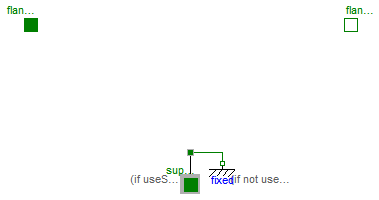
This is a 1-dim. translational component with two flanges and a support/housing. It is used e.g., to build up parts of a drive train graphically consisting of several components.
If useSupport=true, the support connector is conditionally enabled
and needs to be connected.
If useSupport=false, the support connector is conditionally disabled
and instead the component is internally fixed to ground.
| Type | Name | Default | Description |
|---|---|---|---|
| Boolean | useSupport | false | = true, if support flange enabled, otherwise implicitly grounded |
| Type | Name | Description |
|---|---|---|
| Flange_a | flange_a | Flange of left end |
| Flange_b | flange_b | Flange of right end |
| Support | support | Support/housing of component |
partial model PartialTwoFlangesAndSupport
"Partial model for a component with two translational 1-dim. shaft flanges and a support used for graphical modeling, i.e., the model is build up by drag-and-drop from elementary components"
parameter Boolean useSupport=false
"= true, if support flange enabled, otherwise implicitly grounded";
Flange_a flange_a "Flange of left end";
Flange_b flange_b "Flange of right end";
Support support if useSupport "Support/housing of component";
protected
Support internalSupport
"Internal support/housing of component (either connected to support, if useSupport=true, or connected to fixed, if useSupport=false)";
Components.Fixed fixed if not useSupport
"Fixed support/housing, if not useSupport";
equation
connect(fixed.flange, internalSupport);
connect(internalSupport, support);
end PartialTwoFlangesAndSupport;
 Modelica.Mechanics.Translational.Interfaces.PartialRigid
Modelica.Mechanics.Translational.Interfaces.PartialRigid

This is a 1-dim. translational component with two rigidly connected flanges. The fixed distance between the left and the right flange is defined by parameter "L". The forces at the right and left flange can be different. It is used e.g., to built up sliding masses.
| Type | Name | Default | Description |
|---|---|---|---|
| Length | L | Length of component, from left flange to right flange (= flange_b.s - flange_a.s) [m] |
| Type | Name | Description |
|---|---|---|
| Flange_a | flange_a | Left flange of translational component |
| Flange_b | flange_b | Right flange of translational component |
partial model PartialRigid
"Rigid connection of two translational 1D flanges "
SI.Position s
"Absolute position of center of component (s = flange_a.s + L/2 = flange_b.s - L/2)";
parameter SI.Length L(start=0)
"Length of component, from left flange to right flange (= flange_b.s - flange_a.s)";
Flange_a flange_a "Left flange of translational component";
Flange_b flange_b "Right flange of translational component";
equation
flange_a.s = s - L/2;
flange_b.s = s + L/2;
end PartialRigid;
 Modelica.Mechanics.Translational.Interfaces.PartialCompliant
Modelica.Mechanics.Translational.Interfaces.PartialCompliant

This is a 1D translational component with a compliant connection of two translational 1D flanges where inertial effects between the two flanges are not included. The absolute value of the force at the left and the right flange is the same. It is used to built up springs, dampers etc.
| Type | Name | Description |
|---|---|---|
| Flange_a | flange_a | Left flange of compliant 1-dim. translational component |
| Flange_b | flange_b | Right flange of compliant 1-dim. translational component |
partial model PartialCompliant "Compliant connection of two translational 1D flanges"Flange_a flange_a "Left flange of compliant 1-dim. translational component"; Flange_b flange_b "Right flange of compliant 1-dim. translational component"; SI.Distance s_rel(start=0) "Relative distance (= flange_b.s - flange_a.s)"; SI.Force f "Force between flanges (positive in direction of flange axis R)"; equation s_rel = flange_b.s - flange_a.s; flange_b.f = f; flange_a.f = -f;end PartialCompliant;
 Modelica.Mechanics.Translational.Interfaces.PartialCompliantWithRelativeStates
Modelica.Mechanics.Translational.Interfaces.PartialCompliantWithRelativeStates

This is a 1-dim. translational component with a compliant connection of two translational 1-dim. flanges where inertial effects between the two flanges are neglected. The basic assumption is that the cut-forces of the two flanges sum-up to zero, i.e., they have the same absolute value but opposite sign: flange_a.f + flange_b.f = 0. This base class is used to built up force elements such as springs, dampers, friction.
The difference to base classe "PartialCompliant" is that the relative distance and the relative velocity are defined as preferred states. The reason is that for a large class of drive trains, the absolute position is quickly increasing during operation. Numerically, it is better to use relative distances between drive train components because they remain in a limited size. For this reason, StateSelect.prefer is set for the relative distance of this component.
In order to improve the numerics, a nominal value for the relative distance should be set, since drive train distances are in a small order and then step size control of the integrator is practically switched off for such a variable. A default nominal value of s_nominal = 1e-4 is defined. This nominal value might also be computed from other values, such as "s_nominal = f_nominal / c" for a spring, if f_nominal and c have more meaningful values for the user.
| Type | Name | Default | Description |
|---|---|---|---|
| Advanced | |||
| StateSelect | stateSelect | StateSelect.prefer | Priority to use phi_rel and w_rel as states |
| Distance | s_nominal | 1e-4 | Nominal value of s_rel (used for scaling) [m] |
| Type | Name | Description |
|---|---|---|
| Flange_a | flange_a | Left flange of compliant 1-dim. translational component |
| Flange_b | flange_b | Right flange of compliant 1-dim. transational component |
partial model PartialCompliantWithRelativeStates
"Base model for the compliant connection of two translational 1-dim. shaft flanges where the relative position and relative velocities are used as states"
parameter StateSelect stateSelect=StateSelect.prefer
"Priority to use phi_rel and w_rel as states";
parameter SI.Distance s_nominal=1e-4
"Nominal value of s_rel (used for scaling)";
SI.Distance s_rel(start=0, stateSelect=stateSelect, nominal=s_nominal)
"Relative distance (= flange_b.s - flange_a.s)";
SI.Velocity v_rel(start=0, stateSelect=stateSelect)
"Relative velocity (= der(s_rel))";
SI.Force f "Forces between flanges (= flange_b.f)";
Translational.Interfaces.Flange_a flange_a
"Left flange of compliant 1-dim. translational component";
Translational.Interfaces.Flange_b flange_b
"Right flange of compliant 1-dim. transational component";
equation
s_rel = flange_b.s - flange_a.s;
v_rel = der(s_rel);
flange_b.f = f;
flange_a.f = -f;
end PartialCompliantWithRelativeStates;
 Modelica.Mechanics.Translational.Interfaces.PartialElementaryOneFlangeAndSupport
Modelica.Mechanics.Translational.Interfaces.PartialElementaryOneFlangeAndSupport
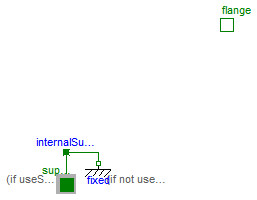
This is a 1-dim. translational component with one flange and a support/housing. It is used to build up elementary components of a drive train with equations in the text layer.
If useSupport=true, the support connector is conditionally enabled
and needs to be connected.
If useSupport=false, the support connector is conditionally disabled
and instead the component is internally fixed to ground.
Extends from Modelica.Icons.ObsoleteModel (Icon for classes that are obsolete and will be removed in later versions).
| Type | Name | Default | Description |
|---|---|---|---|
| Boolean | useSupport | false | = true, if support flange enabled, otherwise implicitly grounded |
| Type | Name | Description |
|---|---|---|
| Flange_b | flange | Flange of component |
| Support | support | Support/housing of component |
partial model PartialElementaryOneFlangeAndSupport
"Obsolete partial model. Use PartialElementaryOneFlangeAndSupport2."
extends Modelica.Icons.ObsoleteModel;
parameter Boolean useSupport=false
"= true, if support flange enabled, otherwise implicitly grounded";
Modelica.SIunits.Length s = flange.s - internalSupport.s
"Distance between flange and support (= flange.s - support.s)";
Flange_b flange "Flange of component";
protected
InternalSupport internalSupport(f=-flange.f)
"Internal support/housing of component as a model with connector flange (flange is either connected to support, if useSupport=true, or connected to fixed, if useSupport=false)";
Components.Fixed fixed if not useSupport
"Fixed support/housing, if not useSupport";
public
Support support if useSupport "Support/housing of component";
equation
connect(internalSupport.flange, support);
connect(fixed.flange, internalSupport.flange);
end PartialElementaryOneFlangeAndSupport;
 Modelica.Mechanics.Translational.Interfaces.PartialElementaryOneFlangeAndSupport2
Modelica.Mechanics.Translational.Interfaces.PartialElementaryOneFlangeAndSupport2

This is a 1-dim. translational component with one flange and a support/housing. It is used to build up elementary components of a drive train with equations in the text layer.
If useSupport=true, the support connector is conditionally enabled
and needs to be connected.
If useSupport=false, the support connector is conditionally disabled
and instead the component is internally fixed to ground.
| Type | Name | Default | Description |
|---|---|---|---|
| Boolean | useSupport | false | = true, if support flange enabled, otherwise implicitly grounded |
| Type | Name | Description |
|---|---|---|
| Flange_b | flange | Flange of component |
| Support | support | Support/housing of component |
partial model PartialElementaryOneFlangeAndSupport2
"Partial model for a component with one translational 1-dim. shaft flange and a support used for textual modeling, i.e., for elementary models"
parameter Boolean useSupport=false
"= true, if support flange enabled, otherwise implicitly grounded";
Modelica.SIunits.Length s = flange.s - s_support
"Distance between flange and support (= flange.s - support.s)";
Flange_b flange "Flange of component";
Support support(s=s_support, f=-flange.f) if useSupport
"Support/housing of component";
protected
Modelica.SIunits.Length s_support "Absolute position of support flange";
equation
if not useSupport then
s_support = 0;
end if;
end PartialElementaryOneFlangeAndSupport2;
 Modelica.Mechanics.Translational.Interfaces.PartialElementaryTwoFlangesAndSupport
Modelica.Mechanics.Translational.Interfaces.PartialElementaryTwoFlangesAndSupport
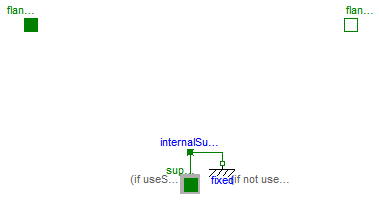
This is a 1-dim. translational component with two flanges and an additional support. It is used e.g., to build up elementary ideal gear components. The component contains the force balance, i.e., the sum of the forces of the connectors is zero (therefore, components that are based on PartialGear cannot have a mass). The support connector needs to be connected to avoid the unphysical behavior that the support force is required to be zero (= the default value, if the connector is not connected).
Extends from Modelica.Icons.ObsoleteModel (Icon for classes that are obsolete and will be removed in later versions).
| Type | Name | Default | Description |
|---|---|---|---|
| Boolean | useSupport | false | = true, if support flange enabled, otherwise implicitly grounded |
| Type | Name | Description |
|---|---|---|
| Flange_a | flange_a | Flange of left shaft |
| Flange_b | flange_b | Flange of right shaft |
| Support | support | Support/housing of component |
partial model PartialElementaryTwoFlangesAndSupport
"Obsolete partial model. Use PartialElementaryTwoFlangesAndSupport2."
extends Modelica.Icons.ObsoleteModel;
parameter Boolean useSupport=false
"= true, if support flange enabled, otherwise implicitly grounded";
Flange_a flange_a "Flange of left shaft";
Flange_b flange_b "Flange of right shaft";
Modelica.SIunits.Length s_a = flange_a.s - internalSupport.s
"Distance between left flange and support";
Modelica.SIunits.Length s_b = flange_b.s - internalSupport.s
"Distance between right flange and support";
protected
InternalSupport internalSupport(f=-flange_a.f - flange_b.f)
"Internal support/housing of component as a model with connector flange (flange is either connected to support, if useSupport=true, or connected to fixed, if useSupport=false)";
Components.Fixed fixed if not useSupport
"Fixed support/housing, if not useSupport";
public
Support support if useSupport "Support/housing of component";
equation
connect(internalSupport.flange, support);
connect(fixed.flange, internalSupport.flange);
end PartialElementaryTwoFlangesAndSupport;
 Modelica.Mechanics.Translational.Interfaces.PartialElementaryTwoFlangesAndSupport2
Modelica.Mechanics.Translational.Interfaces.PartialElementaryTwoFlangesAndSupport2

This is a 1-dim. translational component with two flanges and an additional support. It is used e.g., to build up elementary ideal gear components. The component contains the force balance, i.e., the sum of the forces of the connectors is zero (therefore, components that are based on PartialGear cannot have a mass). The support connector needs to be connected to avoid the unphysical behavior that the support force is required to be zero (= the default value, if the connector is not connected).
| Type | Name | Default | Description |
|---|---|---|---|
| Boolean | useSupport | false | = true, if support flange enabled, otherwise implicitly grounded |
| Type | Name | Description |
|---|---|---|
| Flange_a | flange_a | Flange of left shaft |
| Flange_b | flange_b | Flange of right shaft |
| Support | support | Support/housing of component |
partial model PartialElementaryTwoFlangesAndSupport2
"Partial model for a component with one translational 1-dim. shaft flange and a support used for textual modeling, i.e., for elementary models"
parameter Boolean useSupport=false
"= true, if support flange enabled, otherwise implicitly grounded";
Flange_a flange_a "Flange of left shaft";
Flange_b flange_b "Flange of right shaft";
Support support(s=s_support, f = -flange_a.f - flange_b.f) if useSupport
"Support/housing of component";
Modelica.SIunits.Length s_a = flange_a.s - s_support
"Distance between left flange and support";
Modelica.SIunits.Length s_b = flange_b.s - s_support
"Distance between right flange and support";
protected
Modelica.SIunits.Length s_support "Absolute position of support flange";
equation
if not useSupport then
s_support = 0;
end if;
end PartialElementaryTwoFlangesAndSupport2;
 Modelica.Mechanics.Translational.Interfaces.PartialElementaryRotationalToTranslational
Modelica.Mechanics.Translational.Interfaces.PartialElementaryRotationalToTranslational
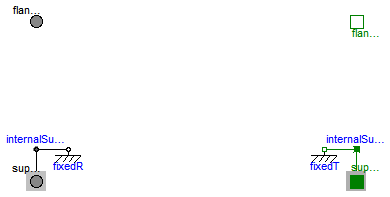
This is a 1-dim. rotational component with
This model is used to build up elementary components of a drive train transforming rotational into translational motion with equations in the text layer.
If useSupportR=true, the rotational support connector is conditionally enabled and needs to be connected.
If useSupportR=false, the rotational support connector is conditionally disabled and instead the rotational part is internally fixed to ground.
If useSupportT=true, the translational support connector is conditionally enabled and needs to be connected.
If useSupportT=false, the translational support connector is conditionally disabled and instead the translational part is internally fixed to ground.
Extends from Modelica.Mechanics.Rotational.Interfaces.PartialElementaryRotationalToTranslational (Partial model to transform rotational into translational motion).
| Type | Name | Default | Description |
|---|---|---|---|
| Boolean | useSupportR | false | = true, if rotational support flange enabled, otherwise implicitly grounded |
| Boolean | useSupportT | false | = true, if translational support flange enabled, otherwise implicitly grounded |
| Type | Name | Description |
|---|---|---|
| Flange_a | flangeR | Flange of rotational shaft |
| Flange_b | flangeT | Flange of translational rod |
| Support | supportR | Rotational support/housing of component |
| Support | supportT | Translational support/housing of component |
partial model PartialElementaryRotationalToTranslational "Partial model to transform rotational into translational motion" extends Modelica.Mechanics.Rotational.Interfaces.PartialElementaryRotationalToTranslational;end PartialElementaryRotationalToTranslational;
 Modelica.Mechanics.Translational.Interfaces.PartialForce
Modelica.Mechanics.Translational.Interfaces.PartialForce

Partial model of force that accelerates the flange.
If useSupport=true, the support connector is conditionally enabled
and needs to be connected.
If useSupport=false, the support connector is conditionally disabled
and instead the component is internally fixed to ground.
Extends from PartialElementaryOneFlangeAndSupport2 (Partial model for a component with one translational 1-dim. shaft flange and a support used for textual modeling, i.e., for elementary models).
| Type | Name | Default | Description |
|---|---|---|---|
| Boolean | useSupport | false | = true, if support flange enabled, otherwise implicitly grounded |
| Type | Name | Description |
|---|---|---|
| Flange_b | flange | Flange of component |
| Support | support | Support/housing of component |
partial model PartialForce
"Partial model of a force acting at the flange (accelerates the flange)"
extends PartialElementaryOneFlangeAndSupport2;
Modelica.SIunits.Force f = flange.f
"Accelerating force acting at flange (= flange.f)";
end PartialForce;
 Modelica.Mechanics.Translational.Interfaces.PartialAbsoluteSensor
Modelica.Mechanics.Translational.Interfaces.PartialAbsoluteSensor

This is the superclass of a 1D translational component with one flange and one output signal in order to measure an absolute kinematic quantity in the flange and to provide the measured signal as output signal for further processing with the Modelica.Blocks blocks.
Extends from Modelica.Icons.TranslationalSensor (Icon representing a linear measurement device).
| Type | Name | Description |
|---|---|---|
| Flange_a | flange | Flange to be measured (flange axis directed in to cut plane, e. g. from left to right) |
partial model PartialAbsoluteSensor "Device to measure a single absolute flange variable" extends Modelica.Icons.TranslationalSensor;Interfaces.Flange_a flange "Flange to be measured (flange axis directed in to cut plane, e. g. from left to right)"; equation 0 = flange.f;end PartialAbsoluteSensor;
 Modelica.Mechanics.Translational.Interfaces.PartialRelativeSensor
Modelica.Mechanics.Translational.Interfaces.PartialRelativeSensor

This is a superclass for 1D translational components with two rigidly connected flanges and one output signal in order to measure relative kinematic quantities between the two flanges or the cut-force in the flange and to provide the measured signal as output signal for further processing with the Modelica.Blocks blocks.
Extends from Modelica.Icons.TranslationalSensor (Icon representing a linear measurement device).
| Type | Name | Description |
|---|---|---|
| Flange_a | flange_a | (left) driving flange (flange axis directed in to cut plane, e. g. from left to right) |
| Flange_b | flange_b | (right) driven flange (flange axis directed out of cut plane) |
partial model PartialRelativeSensor "Device to measure a single relative variable between two flanges" extends Modelica.Icons.TranslationalSensor;Interfaces.Flange_a flange_a "(left) driving flange (flange axis directed in to cut plane, e. g. from left to right)"; Interfaces.Flange_b flange_b "(right) driven flange (flange axis directed out of cut plane)"; equation 0 = flange_a.f + flange_b.f;end PartialRelativeSensor;
Basic model for Coulomb friction that models the stuck phase in a reliable way.
| Type | Name | Default | Description |
|---|---|---|---|
| Advanced | |||
| Velocity | v_small | 1e-3 | Relative velocity near to zero (see model info text) [m/s] |
partial model PartialFriction
"Base model of Coulomb friction elements"
//extends Translational.Interfaces.PartialRigid;
parameter SI.Velocity v_small=1e-3
"Relative velocity near to zero (see model info text)";
// Equations to define the following variables have to be defined in subclasses
SI.Velocity v_relfric "Relative velocity between frictional surfaces";
SI.Acceleration a_relfric "Relative acceleration between frictional surfaces";
//SI.Force f "Friction force (positive, if directed in opposite direction of v_rel)";
SI.Force f0 "Friction force for v=0 and forward sliding";
SI.Force f0_max "Maximum friction force for v=0 and locked";
Boolean free "true, if frictional element is not active";
// Equations to define the following variables are given in this class
Real sa(unit="1")
"Path parameter of friction characteristic f = f(a_relfric)";
Boolean startForward(start=false, fixed=true)
"true, if v_rel=0 and start of forward sliding";
Boolean startBackward(start=false, fixed=true)
"true, if v_rel=0 and start of backward sliding";
Boolean locked(start=false) "true, if v_rel=0 and not sliding";
constant Integer Unknown=3 "Value of mode is not known";
constant Integer Free=2 "Element is not active";
constant Integer Forward=1 "v_rel > 0 (forward sliding)";
constant Integer Stuck=0
"v_rel = 0 (forward sliding, locked or backward sliding)";
constant Integer Backward=-1 "v_rel < 0 (backward sliding)";
Integer mode(
final min=Backward,
final max=Unknown,
start=Unknown, fixed=true);
protected
constant SI.Acceleration unitAcceleration = 1;
constant SI.Force unitForce = 1;
equation
/* Friction characteristic
(locked is introduced to help the Modelica translator determining
the different structural configurations,
if for each configuration special code shall be generated)
*/
startForward = pre(mode) == Stuck and (sa > f0_max/unitForce or pre(startForward)
and sa > f0/unitForce) or pre(mode) == Backward and v_relfric > v_small or
initial() and (v_relfric > 0);
startBackward = pre(mode) == Stuck and (sa < -f0_max/unitForce or pre(
startBackward) and sa < -f0/unitForce) or pre(mode) == Forward and v_relfric <
-v_small or initial() and (v_relfric < 0);
locked = not free and not (pre(mode) == Forward or startForward or pre(
mode) == Backward or startBackward);
a_relfric/unitAcceleration = if locked then 0 else
if free then sa else
if startForward then sa - f0_max/unitForce else
if startBackward then sa + f0_max/unitForce else
if pre(mode) == Forward then sa - f0_max/unitForce else
sa + f0_max/unitForce;
/* Friction torque has to be defined in a subclass. Example for a clutch:
f = if locked then sa else
if free then 0 else
cgeo*fn*(if startForward then Math.tempInterpol1( v_relfric, mue_pos, 2) else
if startBackward then -Math.tempInterpol1(-v_relfric, mue_pos, 2) else
if pre(mode) == Forward then Math.tempInterpol1( v_relfric, mue_pos, 2) else
-Math.tempInterpol1(-v_relfric, mue_pos, 2));
*/
// finite state machine to determine configuration
mode = if free then Free else
(if (pre(mode) == Forward or pre(mode) == Free or startForward) and v_relfric > 0 then
Forward else
if (pre(mode) == Backward or pre(mode) == Free or startBackward) and v_relfric < 0 then
Backward else
Stuck);
end PartialFriction;